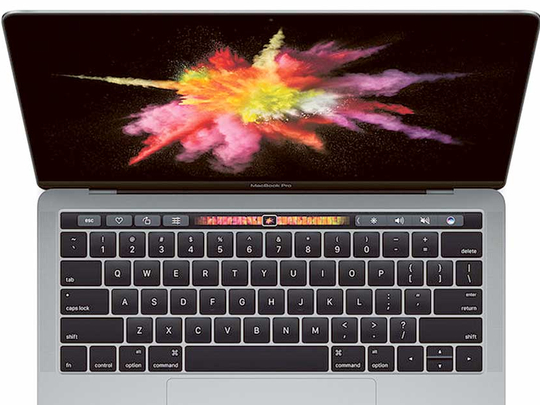
It’s no secret why Apple removed the word “computer” from its name in 2007. For the last 10 years, the Cupertino-based company has made a bigger name for itself from its iPhone — and by extension its mobile operating system — then it ever did from its computers.
Apple’s line of computers have certainly been helped by the success of the iPhone, but the rate of innovation for its MacBook line — and this goes for just about every computer manufacturer — just hasn’t kept with the smartphones.
So its shouldn’t come as a surprise that someone would eventually get the idea to try to introduce smartphone technology into its laptop, which is what Apple has done with its new line of MacBook Pros. It’s an interesting step, designed to make some functions easier and more accessible.
The TouchBar
The iOS technology comes in the form of a TouchBar, a narrow touchscreen that runs across the computer where the Functions keys used to be. You remember the functions keys — those oddly placed keys above the numbers? Their origins are lost in the ‘70s and remembered now only by Unix users.
The TouchBar now takes their place and adds functions you’ll recognise from your iPhone, such as the ability to adjust the volume with a slide bar, scrolling through photos or even sharing files through email or drop box. At its best, this bar will make you appreciate just how far smartphones have advanced the way we interact with computers. Being able to use a touch sliders to scroll through pictures is much faster that Windows-based editing, so its addition to the laptop is very welcome.
The TouchBar even has some basic OS features built in too, but frankly, the majority of the TouchScreen’s potential comes from apps — or would if the app designers would incorporate them into their software. Many Apple products, such as Pages, and some major software suites such as Adobe, already have a number of functions built in that remove the need to navigate through drop-down menus. But not every third-party software developer has caught up. Google Chrome, for example, offers the ability to format text, not really relevant when you’re web browsing.
There is also a downside to the TouchBar.
In pushing the TouchBar, Apple has asked for a moment of silence for the Function Keys. But the death of the function keys has been highly exaggerated. Sure, you’re never going to use them while web browsing or watching videos, but if you actually use your computer for work or games, the new Apple Mac Book pro is going to make you miss them now that they’re gone.
But to be fair, those keys are still there. Holding down the FN key will gives your TouchBar a virtual row of function keys, but the experience is going to be a little disruptive until your fingers get used to the new configuration.
Apple’s biggest crime with the TouchBar, though, is the removal of a physical escape key. A virtual escape key is still there, but it just doesn’t work or feel the same. The old escape key was a lighting rod for all the frustration you ever felt at your computer, and it almost always (OK, sometimes) got you out of whatever jam you were in, minus a system restart. This new virtual key just beeps at you.
Beyond the TouchBar though, there isn’t much to really distinguish this MacBook Pro from previous generations in terms of usability. There are, of course, the upgraded components you would expected in a major overhaul. The MacBook Pro now comes with up to 16GB of memory, a i7 processor and a Radeon Pro 450 graphics card, although these features are exclusive to the higher end 15-inch models. Those opting for the more portable 13-inch models will have to make do with i5 chips and Intel-based graphics.
These system come with four Thunderbolt 3 drives, which will probably frustrate those of us still using regular USB-connected peripherals, so we suggest picking up a few adapters before you leave the store.
There is also one oddity to the MacBook. It still has a headphone jack but there is no port for a lightning connector, meaning those new earbuds you got with your iPhone 7 will not work with the New MacBook Pro. Hope you didn’t throw out your old earbuds.
The stumbling point for many people hasn’t been the headphones, it’s been the price tag.
Have no doubt, these are premium notebooks with a strong emphasis on portability and design, but you’re really going to have to be a fan of the Apple ecosystem to justify the price. The entry level MacBook Pro — which doesn’t even come with the TouchBar — is going to set you back $1,400 (Dh5,140), about the same price you can get a fully loaded Windows-based machine for. A fully load MacBook Pro comes with a $2,700 sticker price. That’s about $700 more than a fully customised Alienware laptop, a premium gaming brand which boasts much higher specs. However, the MacBook won’t dislocate your shoulder if you have to carry it around all day.
You’re probably best to think of it this way. If you like Apple and all it has to offer, the new MacBook Pro is most likely the update you’ve been waiting for. But a cost-conscious consumer unfamiliar with the MacBook Pro may be in for a case of buyer’s remorse.












